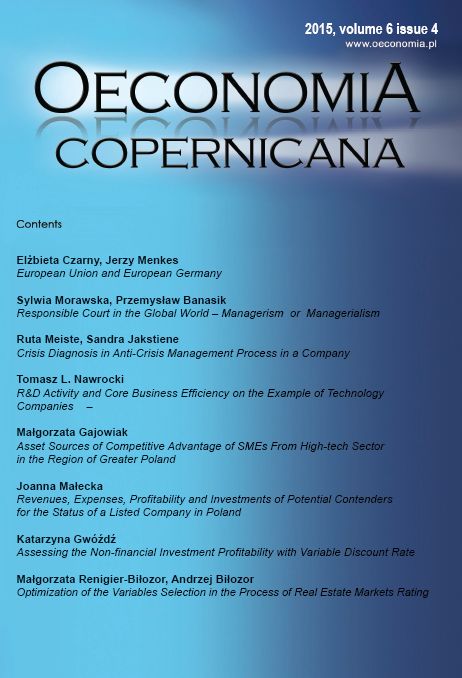Optimization of the variables selection in the process of real estate markets rating
DOI:
https://doi.org/10.12775/OeC.2015.033Keywords:
real estate market rating, optimization of the variables selection, Hellwig’s methodAbstract
The growing significance of the real estate market prompts investors to search for factors and variables which support cohesive analyses of real estate markets, market comparisons based on diverse criteria and determination of market potential. The specificity of the real estate market is determined by the unique attributes of property. The Authors assume that developing real estate market ratings identifies the types of information and factors which affect decision-making on real estate markets. The main objective of real estate market ratings is to create a universal and standardized classification system for evaluating the real estate market. One of the most important problems in this area is collecting appropriate features of real estate market and development dataset. The main problem involves the selection and application of appropriate features, which would be relevant to the specificity of information related to the real estate market and create a kind of coherent system aiding the decision-making process. The main aim of this study is the optimization of set of variables that were used to develop the real estate market ratings. For this purpose, Hellwig?s method of integral capacity of information was applied. In this particular case, the method shows what set of variables provides information most sufficiently. The results lead to obtaining the necessary set of features that constitute essential information which describes the situation on the local real estate market.
Downloads
References
Beracha, E., & Skiba, H. (2011). Momentum in Residential Real Estate. Journal Of Real Estate Finance And Economics, 43(3). http://dx.doi.org/10.1007/ s11146-009-9210-2.
Bryx, M., & Matkowski, R. (2001). Inwestycje w nieruchomości. Warszawa: Poltext.
Case, K. E., & Shiller, R. J. (1989). The Efficiency of the Market for Single-Family Homes. American Economic Review, 79(1). DOI: http://dx.doi.org /10.3386/w2506.
Case, K. E., & Shiller, R. J. (1990). Forecasting Prices and Excess Returns in the Housing Market. Real Estate Economics, 18(3). http://dx.doi.org/10.1111 /1540-6229.00521.
Case, K. (2000). Real Estate and the macroeconomy. Brookings Papers of Economic Activity, 2. http://dx.doi.org/10.1353/eca.2000.0011.
Collett, D., Lizieri, C., & Ward, C. (2003). Timing and the Holding Periods of Institutional Real Estate. Real Estate Economics 31(2). http://dx.doi.org/10.11 11/1540-6229.00063.
Dawidowicz, A., Renigier-Biłozor M., & Radzewicz, A. (2014). An algorithm for the purposes of determining the real estate markets efficiency in Land Administration System. Survey Review, 46(336). DOI: http://dx.doi.org/10.1 179/1752270613Y.0000000080.
Fama, E., (1990). Efficient Capital Markets: II. Journal of finance, 46(5). http://dx.doi.org/10.2307/2328565.
Grossman, S. J., & Stiglitz, J. E. (1980). On the Impossibility of Informationally Efficient Markets. American Economic Review, 70.
Hellwig, Z. (1976). Przechodniość relacji skorelowania zmiennych losowych i płynące stąd wnioski ekonometryczne. Przegląd Statystyczny, 23(1).
Renigier-Biłozor, M., & Wiśniewski, R. (2012). The Effectiveness of Real Estate Market Participants. European Spatial Research and Policy. 19(1).
Renigier-Biłozor, M. (2013). Structure of a decision support subsystem in real estate management. Folia Oeconomica Stetinensia, 13(21). http://dx.doi.org/ 10.2478/foli-2013-0007.
Renigier-Biłozor, M., Wiśniewski, R., Biłozor, A., & Kaklauskas, A. (2014). Rating methodology for real estate markets ? Poland case study. International Journal of strategic property management. 18(2). http://dx.doi.org/10.3846/ 1648715X.2014.927401.
Kaklauskas, A., Kelpsiene, L., Zavadskas, E. K., Bardauskiene, D., Kaklauskas, G., Urbonas, M., & Sorakas, V. (2011). Crisis management in construction and real estate: Conceptual modeling at the micro-, meso- and macro-levels. Land Use Policy, 28. http://dx.doi.org/10.1016/j.landusepol.2010.06.008.
Źróbek, S., & Grzesik, C. (2013). Modern Challenges Facing the Valuation Profession and Allied University Education in Poland. Real Estate Management and Valuation, 21(1). http://dx.doi.org/10.2478/remav-2013-0002.






